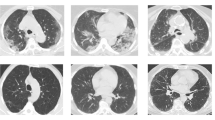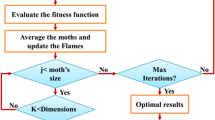Abstract
The new coronavirus has been declared as a global emergency. The first case was officially declared in Wuhan, China, during the end of 2019. Since then, the virus has spread to nearly every continent, and case numbers continue to rise. The scientists and engineers immediately responded to the virus and presented techniques, devices and treatment approaches to fight back and eliminate the virus. Machine learning is a popular scientific tool and is applied to several medical image recognition problems, involving tumour recognition, cancer detection, organ transplantation and COVID-19 diagnosis. It is proved that machine learning presents robust, fast and accurate results in various medical image recognition problems. Generally, machine learning-based frameworks consist of two stages: feature extraction and classification. In the feature extraction, overwhelmingly unsupervised learning techniques are applied to reduce the input data’s size. This step extracts appropriate features by reducing the computational time and increasing the performance of the classifiers. A classifier is the second step that aims to categorise the input. Within the proposed step, the unsupervised part relies on the feature extraction by using local binary patterns (LBP), followed by feature selection relying on factor analysis technique. The LBP is a kind of visual descriptor, mainly applied for image recognition problem. The aim of using LBP is to analyse the input COVID-19 image and extract salient features. Furthermore, factor analysis is a statistical technique applied to define variability among observed variables in less unnoticed variables named factors. The factor analysis applied to the LBP wavelet aims to select sensitive features from input data (LBP output) and reduce the size input. In the last stage, conic functions classifier is applied to classify two sets of data, categorising the extracted features by using LBP and factor analysis as positive or negative COVID-19 cases.
The proposed solution aims to diagnose COVID-19 by using LBP and factor analysis, based on conic functions classifier. The conic functions classifier presents remarkable results compared with these popular classifiers and state-of-the-art studies presented in the literature.
Access this chapter
Tax calculation will be finalised at checkout
Purchases are for personal use only
Similar content being viewed by others
References
E.A. Severo, J.C.F. De Guimarães, M.L. Dellarmelin, Impact of the COVID-19 pandemic on environmental awareness, sustainable consumption and social responsibility: Evidence from generations in Brazil and Portugal. J. Clean. Prod. 286, 124947 (2020). https://doi.org/10.1016/j.jclepro.2020.124947. ISSN 0959-6526
W. Heo, A. Rabbani, J.E. Grable, An evaluation of the effect of the COVID-19 pandemic on the risk tolerance of financial decision makers. Financ. Res. Lett. 2020, 101842 (2020). https://doi.org/10.1016/j.frl.2020.101842. ISSN 1544-6123
F. Altuntas, M.S. Gok, The effect of COVID-19 pandemic on domestic tourism: A DEMATEL method analysis on quarantine decisions. Int. J. Hosp. Manage. 92, 102719 (2022). https://doi.org/10.1016/j.ijhm.2020.102719. ISSN 0278-4319
General Office of National Health Committee, Of a Program for the Diagnosis and Treatment Notice on the Issuance of Novel Coronavirus (2019-nCoV) Infected Pneumonia (trial sixth edition) (2020-02-18). http://www.nhc.gov.cn/yzygj/s7653p/202002/8334a8326dd94d329df351d7da8aefc2.shtml?from=timeline. Accessed 24 Feb 2020
M. Chung, A. Bernheim, X. Mei, et al., CT imaging features of 2019 novel coronavirus (2019-nCoV). Radiology (2020). https://doi.org/10.1148/radiol.2020200230
P. Huang, T. Liu, L. Huang, et al., Use of chest CT in combination with negative RT-PCR assay for the 2019 novel coronavirus but high clinical suspicion. Radiology (2020). https://doi.org/10.1148/radiol.2020200330
P. Puri, N. Comfere, L.A. Drage, H. Shamim, S.A. Bezalel, M.R. Pittelkow, M.D.P. Davis, M. Wang, A.R. Mangold, M.M. Tollefson, J.S. Lehman, A. Meves, J.A. Yiannias, C.C. Otley, R.E. Carter, O. Sokumbi, M.R. Hall, A.G. Bridges, D.H. Murphree, Deep learning for dermatologists: Part II. Current applications. J. Am. Acad. Dermatol. (2020). https://doi.org/10.1016/j.jaad.2020.05.053. ISSN 0190-9622
Y. Tian, F. Saiji, A descriptive framework for the field of deep learning applications in medical images. Knowl. Based Syst. 210, 106445 (2020). https://doi.org/10.1016/j.knosys.2020.106445. ISSN 0950-7051
C. Stefano, S. Shanmukh, C. Federico, Applications of deep learning in dentistry. Oral Surg. Oral Med. Oral Pathol. Oral Radiol. (2020). https://doi.org/10.1016/j.oooo.2020.11.003. ISSN 2212-4403
Z. Tong, J. Gao, D. Yuan, Advances of deep learning applications in ground-penetrating radar: A survey. Construct. Build. Mater. 258, 120371 (2020). https://doi.org/10.1016/j.conbuildmat.2020.120371. ISSN 0950-0618
R. Lu, X. Zhao, J. Li, P. Niu, B. Yang, H. Wu, et al., Genomic characterisation and epidemiology of 2019 novel coronavirus: Implications for virus origins and receptor binding. Lancet 395(10224), 565–574 (2020)
H. Panwar, P.K. Gupta, M.K. Siddiqui, R. Morales-Menendez, V. Singh, Application of deep learning for fast detection of COVID-19 in X-rays using nCOVnet. Chaos Solitons Fractals 138, 109944 (2020). https://doi.org/10.1016/j.chaos.2020.109944
T. Zebin, S. Rezvy, COVID-19 detection and disease progression visualization: Deep learning on chest X-rays for classification and coarse localization. Appl. Intell. (2020). https://doi.org/10.1007/s10489-020-01867-1
M.A. Elaziz, K.M. Hosny, A. Salah, M.M. Darwish, S. Lu, et al., New machine learning method for image-based diagnosis of COVID-19. PLoS One 15(6), e0235187 (2020). https://doi.org/10.1371/journal.pone.0235187
M.Z.C. Azemin, R. Hassan, M.I.M. Tamrin, M.A.M. Ali, COVID-19 deep learning prediction model using publicly available radiologist-adjudicated chest X-ray images as training data: Preliminary findings. Int. J. Biomed. Imag. 2020, 8828855 (2020). https://doi.org/10.1155/2020/8828855
K. Kaplan, Y. Kaya, M. Kuncan, H.M. Ertunç, Brain tumor classification using modified local binary patterns (LBP) feature extraction methods. Med. Hypotheses 139, 109696 (2020). https://doi.org/10.1016/j.mehy.2020.109696. ISSN 0306-9877
K. Kaplan, Y. Kaya, M. Kuncan, M.R. Minaz, H.M. Ertunç, An improved feature extraction method using texture analysis with LBP for bearing fault diagnosis. Appl. Soft Comput. 87, 106019 (2020). https://doi.org/10.1016/j.asoc.2019.106019. ISSN 1568-4946
J. Tang, Q. Su, B. Su, S. Fong, W. Cao, X. Gong, Parallel ensemble learning of convolutional neural networks and local binary patterns for face recognition. Comput. Methods Progr. Biomed. 197, 105622 (2020). https://doi.org/10.1016/j.cmpb.2020.105622. ISSN 0169-2607
A. Güner, Ö.F. Alçin, A. Şengür, Automatic digital modulation classification using extreme learning machine with local binary pattern histogram features. Measurement 145, 214–225 (2019). https://doi.org/10.1016/j.measurement.2019.05.061. ISSN 0263-2241
D. Salas-Gonzalez, J. Górriz, J. Ramírez, I. Illán, M. López, F. Segovia, et al., Feature selection using factor analysis for Alzheimer’s diagnosis using F18-FDG PET images. Med. Phys. 37(11), 6084–6095 (2010). https://doi.org/10.1118/1.3488894
M. Usman, S. Ahmed, J. Ferzund, A. Mehmood, A. Rehman, Using PCA and factor analysis for dimensionality reduction of bio-informatics data. Int. J. Adv. Comput. Sci. Appl. 8(5) (2017). https://doi.org/10.14569/ijacsa.2017.080551
R.N. Gasimov, G. Ozturk, Separation via polyhedral conic functions. Optim. Methods Softw. 21(4), 527–540 (2006)
E. Çimen, A random subspace based conic functions ensemble classifier. Turk. J. Electr. Eng. Comput. Sci. 28(4), 2165–2182 (2020). https://doi.org/10.3906/elk-1911-89
J.P. Cohen, P. Morrison, L. Dao, COVID-19 image data collection. ar**v.2020, https://github.com/ieee8023/covid-chestxray-dataset
L. Wang, A. Wong, COVID-Net: A tailored deep convolutional neural network design for detection of COVID-19 cases from chest radiography images. Ar**v 2200309871 (2020)
X. Li, D. Zhu, COVID-Xpert: An AI powered population screening of COVID-19 cases using chest radiography images. Ar**v:200403042 1–6 (2020)
P. Afshar, S. Heidarian, F. Naderkhani, A. Oikonomou, K.N. Plataniotis, A. Mohammadi et al., -Caps: A capsule network-based framework for identification of Covid-19 cases from X-ray images. Ar**v Prepr Ar**v200402696 1–4 (2020)
M. Farooq, A. Hafeez, “COVID-ResNet: A Deep Learning Framework for Screening of COVID19 from Radiographs”, Ar**v:2003.14395, 2020
T. Ozturk, M. Talo, E.A. Yildirim, U.B. Baloglu, O. Yildirim, U. Rajendra Acharya, Automated detection of COVID-19 cases using deep neural networks with X-ray images. Comput. Biol. Med. 121, 103792 (2020)
A.I. Khan, J.L. Shah, M.M. Bhat, Coronet: A deep neural network for detection and diagnosis of COVID-19 from chest x-ray images. Comput. Methods Prog. Biomed. 196, 105581 (2020)
L. Wang, A. Wong, COVID-Net: A tailored deep convolutional neural network design for detection of COVID-19 cases from chest radiography images. ar**v preprint ar**v:2003.09871 (2020)
Author information
Authors and Affiliations
Corresponding author
Editor information
Editors and Affiliations
Rights and permissions
Copyright information
© 2022 Springer Nature Switzerland AG
About this chapter
Cite this chapter
Karim, A.M., Mishra, A. (2022). Novel COVID-19 Recognition Framework Based on Conic Functions Classifier. In: Garg, L., Chakraborty, C., Mahmoudi, S., Sohmen, V.S. (eds) Healthcare Informatics for Fighting COVID-19 and Future Epidemics. EAI/Springer Innovations in Communication and Computing. Springer, Cham. https://doi.org/10.1007/978-3-030-72752-9_1
Download citation
DOI: https://doi.org/10.1007/978-3-030-72752-9_1
Published:
Publisher Name: Springer, Cham
Print ISBN: 978-3-030-72751-2
Online ISBN: 978-3-030-72752-9
eBook Packages: EngineeringEngineering (R0)




